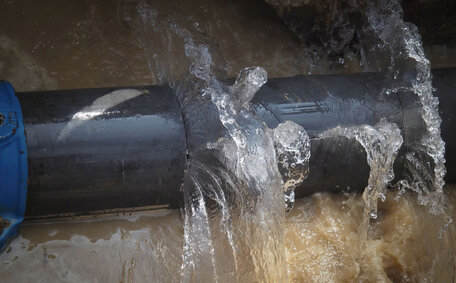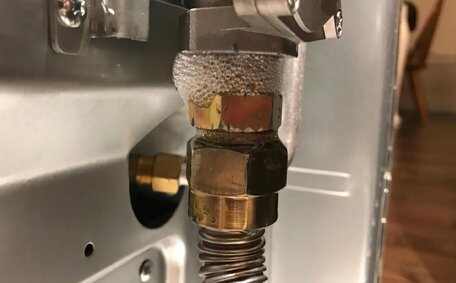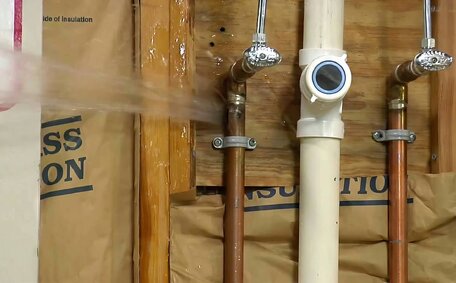Understanding Pipe Relining
Pipe relining involves fixing damaged pipes by inserting a new lining within the existing structure. This trenchless method avoids the need to dig up and replace old pipes, making it less disruptive and more environmentally friendly.
The relining process involves sending a flexible epoxy resin liner into the damaged pipe. The liner is inflated and hardened in place, creating a robust new pipe inside the old one. This seals cracks and fills in gaps around intruding tree root incursions.
The Pipe Relining Process Step-by-Step
The following details the professional plumbers’ approach to pipe relining:
- Inspection. Plumbers deploy a drain camera to inspect the pipe, assessing its condition and the feasibility of relining.
- Cleaning. The drain clearing process involves using pressure water jetting to remove blockages, roots, grease and sediment from the existing pipe.
- Pipe Lining Installation. A resin-impregnated liner is introduced into the pipe and expanded against the interior walls to set and form a seamless new channel.
- Curing. The liner is then cured with hot water or steam, securing the resin to the existing pipe’s interior.
- Second Inspection. A drain camera inspects the relined pipe again to ensure no defects and confirm structural integrity.
- Reconnection. The pipeline is then reconnected, reinstating full functionality to your drainage and plumbing systems.
Correctly installed relined pipes can last over 50 years without needing drain repairs or replacement.
Our team provides superior epoxy resin liners and state-of-the-art methods, ensuring durable, effective repairs for homes and businesses.
Inspecting Relined Pipes
Once a pipe relining project concludes, comprehensive inspection using CCTV drain cameras validates the new liner’s integrity. Pre-relining and post-relining footage is carefully analysed to detect faults or weaknesses unnoticeable to the naked eye.
High-definition drain cameras perform a detailed inspection of the relined pipe’s interior. Specialists check for pinhole leaks, gaps between the liner and original pipe, protruding lateral connections or obstructions that could hamper drainage flow. Early detection allows for minor repairs, averting larger pipe failures.
Smooth, jointless liners with no sags or bulges confirm proper curing and bonding. Only pipes adhering to strict inspection criteria are approved for service resumption.
In summary, relined pipe testing via cable cameras safeguards infrastructure investments, averting future drainage headaches. Partnering with diligent plumbers who perform comprehensive validation on sewer pipes pre- and post-relining gives homeowners confidence in trenchless pipe rehabilitations.
CCTV Inspections
CCTV drain inspections enable detailed analysis of a pipe’s interior after relining. Plumbers utilise remote-controlled cameras to visually inspect the integral pipework.
High-resolution CCTV cameras capture clear footage that assists when you need pipe relining or full pipe replacement by reviewing the following:
- Pinhole leaks or gaps allowing water ingress
- Defective joints between pipe sections
- Protrusions into the pipe’s flow path
- Deformations, bulges and sagging of liner
- Confirmation that lateral connections are intact
- Verification of smooth transitions at bends
Sophisticated tracking tools monitor the drain camera’s location within the pipeline for precise inspections. This means there’s no chance problematic areas will be missed, ensuring accurate identification for minor repairs.
CCTV inspections provide vital quality assurance, ensuring reliable long-term performance from trenchless pipe relining projects.
Pressure and Leak Testing
Pressure and leak tests serve as essential final checks for relined stormwater sewers.
Hydrostatic pressure testing involves sealing off the relined pipe’s ends and filling it with water. The pressure is gradually increased, often to 150% of the pipe’s normal operating pressure. The pipe is monitored to check if it holds this pressure steadily for a sustained duration without leaking.
Air pressure testing is another method plumbers use. Compressed air is used to fill the relined pipe, which should uphold the specified pressures consistently. A loss of pressure indicates escaping air and pinhole leaks.
We meticulously assess pipe relining needs during our pressure/leak checks on all projects, only restoring flow once results meet quality benchmarks.
Flow Rate Analysis
Measuring flow rates is a reliable way to validate pipe relining and ensure your drains are free of potential obstructions. Plumbers use advanced flow monitoring equipment to assess drainage volumes within relined pipes.
Sensors record flow speeds while known quantities of water are released into the system. Volumetric analysis confirms if the anticipated flows are reaching the pipe outlet in the expected time. Slow drainage indicates blockages or liner issues, while efficient flow rates confirm unimpeded pipes.
Quantifying flow rates post-drain relining also helps benchmark drainage capacity. If a relined kitchen sink pipe handles typical dishwasher discharge flows without overflowing, the relining suits household needs. Larger diameter pipes must manage proportionate volumes, so rigorous flow testing scales accordingly.
Maintaining optimal flow rates free of turbulence, vibration, or leaks ensures the relined pipes remain functional for years. We tailor liner dimensions to match your existing pipes so design capacities are maintained long-term.
Ensuring Quality and Integrity of Relined Pipes
Verifying the quality and integrity of relined pipes is paramount to ensure optimal performance and longevity. Our comprehensive inspections for all relining projects include CCTV examination, pressure and leak testing, flow rate evaluations, and additional checks.
CCTV inspections examine the entire interior surface for defects like cracks or bulges. Pressure testing involves sealing relined pipe ends and increasing water pressure incrementally to ensure there’s no blocked drain occurrence and to check for leaks.
Smooth, jointless liners with no protrusions confirm quality installations. Benchmarking flow rates against design capacities also validates unimpeded drainage.
Our exhaustive testing protocols certify relined sewer lines are watertight and adhere to stringent quality guidelines before restoring service. This safeguards infrastructure investments, delivering reliable performance for decades. Partnering with reputable plumbers who perform comprehensive assessments pre- and post-relining instils confidence in trenchless rehabilitations for your property.
Comparing Before and After Data
Comparing CCTV inspection footage and test data before and after pipe relining provides quantitative proof of the procedure’s efficacy. Detailed side-by-side analysis highlights the exact improvements and transformations within the piping system.
Pre-relining footage exposed section pipe areas A and B as severely damaged with over 50% corrosion defects, substantial calcium/root intrusions and numerous joints leaking. Post-relining validation confirmed the epoxy barrier’s smooth, jointless integrity with no breaches or water ingress.
Pressure testing initially demonstrated failures below 0.5 times operating pressures. Post-relining tests certified the pipes now reliably withstand over 1.5 times standard levels, validating long-term robustness.
Flow rate benchmarks showed the original piping struggled to achieve 60% of design capacity due to blockages. After clearing obstructions and sealing leaks, relining restored 90% plus capacity - dramatically improving drainage performance.
By methodically assessing key metrics before and after relining, plumbers quantify upgrades in condition, pressure tolerance and flow rates. This builds customer confidence that non-invasive CIPP repairs offer superior solutions over traditional pipe replacements.
Examining the Internal Lining
Once a pipe relining project is complete, examining the internal lining using CCTV cameras is crucial to validate work quality. Experts meticulously inspect the entire length for deficiencies like cracks, bulges, sagging or poor resin bonding that could compromise integrity.
We thoroughly scan your plumbing system to verify the relined pipes meet stringent benchmarks regarding:
- Continuous smoothness with no protrusions or gaps
- Consistent thickness and concentric alignment
- Fully cured, securely bonded resin without drips or runs
- Intact connections to lateral branches and no obstruction at bends
CCTV examination also confirms the original pipes defective sections are totally sealed by the robust epoxy barrier. Together with pressure testing and flow rate analysis, detailed footage scrutiny provides final confirmation that quality trenchless rehabilitations took place.
Comparing before and after scans validates relining efficacy. We show clients exact improvements - boosting confidence that pipe repairs safeguard plumbing infrastructure long-term.
When Relining Isn’t Possible
In certain situations, pipe relining is not feasible and full replacement becomes necessary:
- When pipes are entirely collapsed or have incurred significant structural damage, relining is incapable of restoring their integrity or function.
- Pipes with over 75% corrosion typically necessitate replacement to prevent future breakdowns.
- Relining cannot correct extensively deformed sections or disjoined pipe connections.
- Materials like clay piping might disintegrate during cleaning, making relining impossible.
- Incompatible pipe diameters or highly angled sections could impede liner installation.
- Asbestos cement and lead piping require replacement due to hazardous material concerns.
Our skilled plumbers conduct thorough inspections and suggest relining if viable. For severely damaged pipes, we suggest complete replacement for a reliable drainage solution.
Although disruptive, starting afresh with new piping removes limitations of working within old inadequate infrastructures. We handle all permitting and excavation works, ensuring your pipes receive seamlessly integrated replacements with long lifespans.
Maintaining Your Relined Pipes
Properly maintaining relined pipes is important to maximise their longevity and performance. We recommend the following care tips:
- Avoid pouring fats, oils or harsh chemicals down drains that could clog pipes or damage liners
- Ensure lateral connections have mesh screens to prevent blocked pipes due to root re-intrusion
- Conduct regular CCTV inspections to check liner condition and identify minor issues early
- Use enzyme drain treatments monthly to control buildup and prevent blocked drains
- Install protective liners around your sewer pipe near trees to defend against root damage
We provide assistance in scheduling biennial maintenance checks after pipe relining. Our repair specialists use cable cameras to inspect drainage systems and uncover early signs of issues such as small cracks or joint defects.
Early intervention extends infrastructure lifespan. We offer comprehensive maintenance plans tailored to homes and businesses across Randwick, Sydney. Contact Randwick Plumbing on 1300 349 338 or [email protected] to discuss your relined pipe upkeep requirements.






